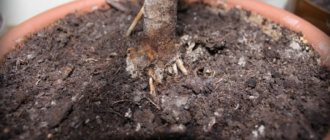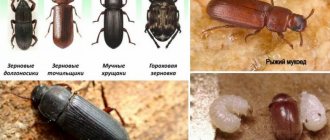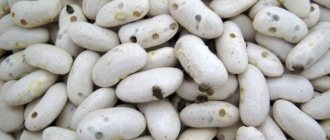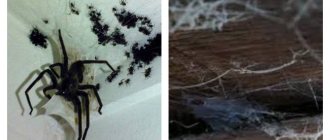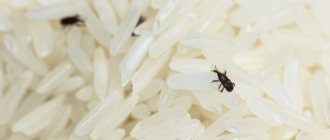A blooming orchid brings true pleasure, amazing the owner :
- Variety of color shades;
- The splendor of rather large flowers;
- And the duration of flowering.
And it seems that proper care is being carried out, favorable conditions have been created, but suddenly some small midges appear , spoiling the whole picture of splendor.
If urgent measures are not taken, then, in addition to the inconvenience, they also seriously harm the plant and can even destroy it.
The main reasons for the appearance of midges
Why did midges appear on the orchid and in its soil? The primary reason for the appearance of different types of midges is the increased humidity of not only the surrounding air, but mainly the soil (substrate). They can fly in from the street or from other indoor plants that require soil or organic matter to be kept in a pot with constant humidity.
Midges appear on orchids due to high humidity.
Often the cause of the appearance may be a poor-quality or unheat-treated soil mixture containing midge larvae , which will quickly begin to spread to other flower pots.
Quite often, when using moss to maintain humidity, gardeners are in no hurry to replace it. As it decomposes, it is a good source of all kinds of flying pests.
Placing vegetables or fruits next to tropical plants causes not only negative consequences for development, but also the appearance of all kinds of insects . And often not harmless.
Prevention measures
To prevent damage to plants, they require proper care. Since a humid environment is attractive to small flies, you should not water orchids frequently or abundantly.
It is not recommended to use artificial moss to decorate the soil, as it becomes a favorable breeding ground for thrips.
It is recommended to use special preparations sold in specialized stores as fertilizer. Attempts to improve soil quality with natural products attract winged pests.
When replanting flowers, it is advisable to use high-quality soil.
Types of these insects
Identification of midges is the main task of the gardener in order to determine the method of combating them:
- Whether they are harmless fruit flies or fungus gnats;
- Or these are thrips with whiteflies that cause significant harm.
Sciarides
Soil or fungus gnats of the family Sciaridae are one of the most ancient groups of dipterous insects. There are more than 20,000 species of this insect in the world. In home floriculture, only three of them are most often found:
- Sciara;
- Licoriella;
- Bradysia.
It is quite difficult for a non-specialist to distinguish them . Some are a little smaller or larger. Some are darker or just a little lighter. Only under a microscope can you figure out which species the plant has chosen.
In most cases, their appearance is associated with larvae in the soil. But often, adult individuals that fly into the window lay eggs in moist soil favorable for reproduction.
Attention! If conditions exist for their life activity, reproduction and nutrition, then it is not possible to get rid of them even with chemicals. The place of dead insects will be taken by newly arrived ones.
Basic conditions for the existence and rapid reproduction of Sciarides:
- Rapidly decomposing organic matter;
- And constantly wet soil.
A small, dipterous (wingless species are rare) mosquito with:
- Narrow body and rounded head;
- Very small in size, depending on the type - 0.5-2 mm.
For orchids, it is not the sciarids themselves that are dangerous, but their larvae.
The legs and abdomen are usually gray or black. The underdevelopment of the oral organs does not allow adult individuals to feed, so they do not pose a danger to the plant .
The danger comes from their larvae, which appear after a few days, when the female lays eggs in moist soil. The larvae are worm-shaped, from 2 to 10 mm in length.
Translucency, translucent intestines and a black head are distinctive features from the annelid , which also prefers a moist substrate with organic elements.
It is the larvae that harm the orchid by eating the roots . The areas of damage begin to rot quite quickly; as a result, the putrefactive process eventually covers the entire root system, which can lead to the death of the plant.
Sciarid larvae cannot tolerate overdried substrate . If they are removed from the substrate, they die in a matter of minutes.
Whiteflies
Many gardeners notice that small white midges have appeared in the soil.
This snow-white, moth-like whitefly, more reminiscent of a miniature moth , poses a real threat to the mostly thin-leaved plant, but large colonies do not disdain fleshy, succulent shoots.
Whitefly body:
- White or yellow-red color;
- Only up to 3 mm long (usually about 1.5 mm);
- The 4 wings fold into a roof-like shape when at rest.
Reproduction occurs frequently and very quickly. a little over a month for a generation of the same age to emerge, from eggs to adult .
Stages of whitefly development.
Females usually lay eggs on the inside of young leaves in groups, in the form of a ring of up to 20-25 pieces. The fertility of females is very high - 130-250 eggs. The larvae that emerge from the eggs have good mobility at first. Having found a convenient feeding site, they attach themselves and draw juices from it.
The most favorite place is the inside of the leaf blade . As they grow up, their body is covered with a waxy coating, with three molting times. After the third molt, they stop moving and feeding, entering the transitional phase of growing up.
It is this period, when the skin hardens and the larva turns into a “false cocoon,” that is beyond the reach of almost any drug, even a systemic one. Therefore, to destroy a colony, complex, repeated and, moreover, systematic treatment is required at certain intervals.
Sucking juice from leaves, stems, damaged parts of the plant :
- Turn yellow;
- And they dry out.
At the location of the colony of larvae and adults, sugary secretions remain, stimulating the appearance of sooty fungus , which causes further harm to the orchid.
Whiteflies reproduce very quickly.
Important! Whiteflies are often carriers of viral infections.
Like most parasites, they prefer places:
- Warm;
- With high humidity;
- Unventilated.
Their appearance in the apartment can occur :
- In open windows;
- Or with the appearance of a new plant.
Fruit midges (drosophila)
Another representative of insects that can appear on an exotic flower is a fruit fly from the order Diptera.
The tropical beauty does not pose any harm or particular danger, but its appearance means the beginning of putrefactive processes in the substrate. In addition, the appearance of fruit flies in the apartment is not very pleasant.
Small in size, with a short life cycle, flies feed on rotting products :
- Moss;
- Leftover tea leaves;
- Fruits;
- Vegetables.
When midges appear in the ground, their presence causes great inconvenience to gardeners. The female can lay more than 400 eggs, from which larvae appear , and adults a week later.
Stages of development of Drosophila flies.
And no matter how harmless fruit flies are, it is necessary to fight them.
Thrips
One of the most dangerous types of insect parasites for any plant. Very small, on average 1-2 mm, with a piercing-sucking type of mouthparts. The slender running legs have a tooth and a bubble-like suction device.
Thrips are one of the most dangerous plant pests.
The main food of thrips is plant cell sap . Reproduction and development are divided into several stages. A female can reproduce about 10-12 generations in a year. Eggs are laid in the tissue of leaf blades, where they go through more than one stage of development:
- After the eggs, larvae appear;
- Then protonymphs and nymphs;
- And only then does an adult appear.
The damage caused by the pest is similar to that of a spider mite . Air enters into the puncture of the tissue of a leaf or other part of the orchid and the process of rotting begins:
- Leaf color changes;
- A silver-colored film appears;
- The leaf turns yellow and falls off.
An orchid attacked by thrips needs isolation and prompt treatment from such harmful parasites that can destroy the plant.
Thrips do not tolerate high humidity .
Chemicals
Radical measures have to be taken when the substrate is already swarming with larvae; it is enough to lift its top layer 1 cm thick to detect them. Unfortunately, many chemicals are toxic and their use in residential areas is undesirable. It is advisable to move orchids affected by midges to a glazed balcony or veranda and spray there.
In enclosed spaces, treatment with the drugs Largon, Mikromit, Difluorobenzuron is allowed, which can destroy adults and larvae; Intavir and Carbofuran are considered stronger. Teflubenzuron affects the life cycle of sciarids and inhibits the process of transformation of larvae into adults, thus preventing an increase in the size of the colony.
Flower growers speak well of the granular product Grom-2, which is scattered on the surface of the substrate and lightly mixed with the top layer. Its consumption rate per 1 sq. m area is only 1-1.5 g, and it is effective until the granules are completely dissolved within 14 days.
Bayer products are considered harmless to humans, which are used both to prevent the appearance of sciarid larvae and to get rid of adult insects. When using the drugs Regent and Regent-800, you should carefully calculate the dosage. If the standard recommended solution is 1 g in 10 liters of water, then for orchids this norm is reduced by at least half. Finally, proven methods of combating house flies are used - Dichlorvos, Raptor sprays, and against larvae - Fly eater.
There are midges in the orchid: what to do?
No chemicals used
How to get rid of flies on orchids? Depending on the type and number of flying pests, methods of controlling them are selected.
If in the fight against fruit flies or whiteflies (not always) you can get by with folk remedies , then when thrips and spider mites appear, folk remedies alone will not be enough.
As preventive measures, they may be effective, but when colonies appear, and especially when eggs have already been laid, only chemical preparations .
Sometimes it is enough to deprive them of their living conditions and food for them to simply disappear from the premises. But this method is not always possible to implement .
When the first whiteflies appear, you can wash the leaf apparatus under running water for a week , thereby preventing the insects from laying eggs by washing them off. Or wipe the entire above-ground part of the plant with a prepared soap solution.
If you have spider mites, the current method is :
- Rubbing cyclamen tubers with infusion;
- Or medical alcohol.
Attention! The leaf apparatus and other parts of the plant in some orchids react negatively to the effects of alcohol, thereby getting burned.
Thrips do not tolerate :
- Onion infusion;
- And olive oil.
Each type of midge needs to be dealt with differently.
How effective this is depends on the spread of parasites. Experienced gardeners often use spray to shine leaves , the coating of which is not liked by thrips and spider mites.
The disadvantage of the spray is that it significantly impedes the processes of photosynthesis .
Also, do not forget about the physiological characteristics of pests. The guarantee of the absence of midges is :
- Proper conditions;
- Lack of food;
- Good immunity;
- And timely preventive treatment.
Velcro and traps
The effect of traps and sticky tapes is especially effective when whiteflies are present on plants. Bright yellow or orange colors attract their attention . Cardboard of this color, smeared with a sticky substance, can lure most insects within a day.
Thrips are also good on sticky tapes, just not the yellow ones . Some gardeners recommend using blue saucers filled with water. Apparently the blue color attracts parasites.
It must be remembered that such control methods are effective for :
- A small (initial) appearance of midges;
- And in the stage when they fly.
They are ineffective in controlling eggs and larvae.
Repellent (citrus fruits, garlic, lavender)
Some insects cannot tolerate essential oils released by some vegetables or fruits. But the plant itself also responds poorly to such secretions.
Lemon or other citrus peel, buried in the substrate, has a repellent effect on thrips. Or you can use garlic infusion applied with a cotton swab to the leaf blades.
Midges are strongly repelled by the smell of citrus fruits.
According to experienced orchid growers, such methods of controlling midges on orchids are ineffective. If they have any effect, it is only repellent or for preventive purposes when there are only a few insects.
Using chemicals
Below you will learn how to treat the plant to combat annoying midges.
Bazudin
An insecticide whose main active ingredient is diazinon . The action of this drug is directed in 3 directions:
- Contact;
- Intestinal;
- And translaminar (penetrates well into plant tissue).
Effective when used in home gardening against fungus gnat larvae and whiteflies in the soil. Mainly used to treat pest-infested soil.
Has a significant drawback. Upon contact with water, during watering or high humidity, a strong, unpleasant odor appears, which is especially noticeable in a confined space , such as an apartment or room.
Grom-2
How to quickly remove midges from an orchid? If the soil is heavily infested with midges and their larvae, folk remedies will not help. the biological preparation Grom-2 to be one of the best remedies .
It most effectively destroys soil midge larvae. The duration of Thunder is calculated for a month .
Advice! After using Grom-2 on orchids, you should stop watering for 3-4 days.
Unlike other chemicals, Grom-2 does not harm the plant and has a hazard class of 4 for people and animals. By following simple safety rules, it will not cause harm to the inhabitants of the apartment .
Aktellik
Non-systemic insectoacaricide. The action of the product is based on direct contact with the pest .
Actellik helps block the work of enzymes in pests.
Once in the parasite's body, Actellik blocks the work of enzymes responsible for neuromuscular transmission of impulses. Having accumulated in the body, all vital functions of the body are disrupted and poisoning occurs, followed by death.
Another positive characteristic of the drug is its fumigant effect , which makes it possible to fight insects on the inside of leaf blades. Showed himself well in the fight:
- With whitefly and its larvae;
- And also when destroying thrips.
It works almost lightning fast. The midges die within minutes. The substances contained in the drug do not cause addiction to it . But still, experienced orchidists recommend combining Actellik with other means of control.
It is recommended that Actellik be used at home only as a last resort due to its toxicity and unsafety for others. In a closed space, it is better to use other means or after treatment not to stay in the room for some time and ventilate it well.
Fury
An insecticide belonging to the class of synthetic pyrethroids. Effective against a large number of insect pests. The advantages of the drug are :
- Broad effect on various types of parasites;
- Does not cause resistance;
- Not phytotoxic;
- Resistant to high temperatures;
- Safe for the environment;
- Economically beneficial.
Reliably protects for two weeks, after which re-treatment is required . Wax-coated whitefly larvae are not affected by Fury, so repeated treatment helps destroy them at a later stage of development.
Aktara
A systemic insecticide with the active chemical thiamethoxane. Recommended for controlling soil-dwelling pests . Experienced orchidists recommend the drug in the fight against thrips and whitefly. Used for pouring soil and spraying on leaves. In combination with Actellik, the process of getting rid of pests is significantly accelerated.
Unlike Actellik, it is not as toxic, which allows it to be used more safely in apartment conditions.
Aktara effectively and quickly destroys pests.
Advantages:
- Performance;
- Efficiency;
- Duration of action.
Flaws:
- Dangerous for animals;
- When processing, personal protective equipment is required;
- There are many fakes on sale.
Raptor
Insecticide against flying insect pests. By affecting the nervous system, it causes paralysis and death. The advantages lie in the rapid destruction of midges by spraying with an aerosol .
Flaws:
- Poses a danger to animals and humans;
- And the room needs to be ventilated after treatment.
Attention! The use of chemicals causes a negative effect on young parts of the plant.
Traditional methods
Many new gardeners ask the question: how to get rid of midges at home? There are several simple and safe folk methods for controlling midges, which often help rid the plant of these annoying and sometimes harmful parasites.
Mustard
There are two ways to use dry regular mustard powder:
- 1 teaspoon of dry powder is diluted in a glass of water. This solution is poured over the substrate. After some time, the larvae, usually located at a depth of no more than 5 cm, will disappear;
Mustard powder is good at killing midges on an orchid. - The surface of the soil is sprinkled with a thin layer of mustard. The procedure is carried out every 5-7 days until the midge or other parasites completely disappear.
river sand
River sand has good reviews from flower growers . Well calcined in the oven for disinfection, sand is sprinkled on top of the soil. If necessary, the procedure should be repeated several times.
Potassium permangantsovka
Watering with a weak solution of potassium permanganate is carried out as needed for 30-50 days. Potassium permanganate dries out the larvae in the soil. It is important to use a weak solution so as not to burn the young orchid roots.
How to get rid of pests at home
If midges have already been found in orchids, how to get rid of them can become a serious problem. You can remove midges in the following ways:
- using folk recipes;
- horticultural chemicals;
- by changing the soil.
Note.
When midges appear in an orchid, first of all, they inspect the foliage and soil. This must be done immediately, before harmful insects cause irreparable damage to the flower bark.
If there are midges, then initially they need to be identified, and then the larvae and adults must be removed and the reasons that caused them must be overcome. It is possible to combat various pests with improvised means. Most orchids, like any flower, are susceptible to attacks from various insects, and not all gardeners trust newfangled chemical compounds. If black midges appear in orchids or white midges are overcome, then it is important to immediately treat the flower. For certain reasons, housewives try to eliminate pests that have infested orchids in the soil with natural compounds.
Small midges in orchids are afraid of the following homemade solutions:
- Pass two cloves of garlic through a garlic press and add hot water, leaving for 4-5 hours. Wipe the foliage on all parts with the solution.
- Dissolve a tablespoon of sunflower or olive oil in half a liter of clean water and spray.
- Soap solution - add a teaspoon of liquid soap to a glass of water and wipe the leaf surface.
The last recipe can also be used as a preventive measure to prevent small midges from infesting. You can make this composition and apply it as soon as one of the symptoms of the disease appears.
Flowers can also be treated with chemical compounds. The most suitable are:
- Fundazol – protects against all types of dew, mold, rot.
- Fitosporin - protects against diseases of a bacterial and fungal nature, can be used for spraying and treating damaged leaves. Use only liquid form.
- Antibiotics.
- Vitamin B.
- Urea.
- Chlorhexidine.
- Iron chelate.
- A mixture of succinic acid and glucose.
- Epin.
- Zircon, Aktelik, Fitoverm, Apollo.
- Nitrogen type fertilizers.
- Based on a mixture of phosphorus and potassium.
Attention!
Each fertilizer must be applied carefully so as not to destroy the flower.
Dampness and mold
Fungus bugs are not the most common pest of indoor plants. They are often confused with fruit flies (Drosophila), although our mosquitoes are darker in color . While fruit flies fly near fruits and rotten foods, sciarids appear near wet soil, sewers and drains.
Fungus gnats are attracted to CO2 (carbon dioxide), which is why they fly straight into your face.
Adults of these midges are 1-2 millimeters in length, thin and similar to very small mosquitoes. These tiny black insects seem harmless because they are just flying around the plant.
But while adult insects sit on the leaves of the Orchid without harming it, their larvae feed on juices from the thin root hairs of the flower . This leads to yellowing of the leaves and weakening of the plant. They can also damage the plant's fragile roots or stems, leaving it vulnerable to rot and infection.
The easiest way to avoid these midges is to water your Orchid properly. It is overwatering and poor drainage that promotes fungi, mold spores and rot that attracts fungus gnats.

